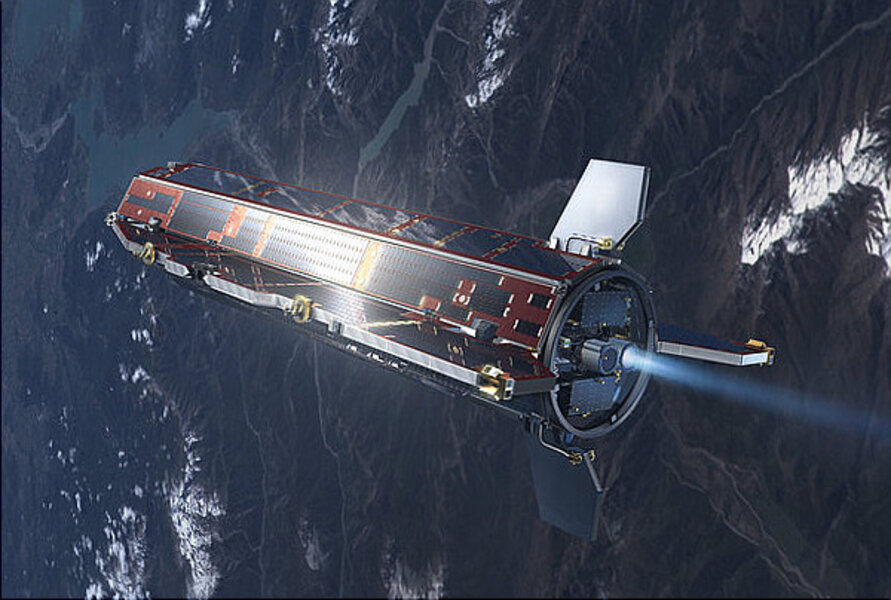Satellite falling: What you need to know about GOCE's descent
The European Space Agency's 2,425-pound satellite is in the process of falling to Earth. Should you worry? Probably not.
This is a planned fall, not an accident or catastrophe. The Gravity field and steady-state Ocean Circulation Explorer (GOCE) has completed its mission, and now that it has run out of fuel, it has reached what ESA calls the "natural end" for the sleek satellite.
"We have obtained the most accurate gravity data ever available to scientists. This alone proves that GOCE was worth the effort – and new scientific results are emerging constantly,” said Volker Liebig, ESA’s Director of Earth Observation Programmes.
Where and when will it hit?
ESA scientists are trying to constrain this further, but for now, they've estimated that the satellite will fracture into 25 to 45 pieces that will make impact on Sunday or Monday, Nov. 10-11. A day before entry, they hope to have that pinned down to a 4-5 hour window. They'll have help from the Inter-Agency Space Debris Coordination Committee, the Defense Department's Space Control and Space Surveillance (SCSS), ESA's Space Debris Office, and NASA's Orbital Debris Program Office.
During its mission, GOCE (pronounced go-chay) orbited Earth every 88 minutes. (You can track the satellite's location here.) Since running out of fuel on Oct. 21, it has fallen like a hang glider, slowly coasting downward.
“Quite literally GOCE is now nearly flying like an airplane without an engine," mission manager Rune Floberghagen told the New York Times,"with the upper layer of the atmosphere providing aerodynamic stabilization."
It is picking up speed as it falls; it initially lost about a mile of altitude per day, but is now falling several miles per day, ESA scientists report.
How common is this?
More than 21,000 objects the size of your hand or larger are currently in orbit, NASA reports. Currently, the SCSS is monitoring the trajectories of more than 16,000 of them, of which 5 percent are still functioning. The rest are rocket bodies, inactive satellites, or other debris. Objects smaller than your hand are harder to count, but NASA estimates that about half a million objects between half an inch and 4 inches across are currently tumbling through Earth orbit, along with more than 100 million particles smaller than a dime. If they fall toward Earth, the smallest objects would burn up in the atmosphere, but the larger chunks have better odds of survival.
"During the past 50 years an average of one cataloged piece of debris fell back to Earth each day," NASA reports, but "no serious injury or significant property damage caused by reentering debris has been confirmed." Most debris doesn't survive the trip through the atmosphere, just like meteors, and the bigger chunks usually fall into the ocean. Despite what you may have learned from Jerry Bruckheimer films, natural disasters do not preferentially target New York, Los Angeles, or other population centers.
About 70 percent of Earth's surface is covered in water, so there's a roughly 2 in 3 chance that anything entering from space will hit water, not land. If falling debris does hit land, odds are fairly good that it will land in Canada, Siberia, the Sahara, Antarctica, or another barely-inhabited corner of the world. Less than a quarter of Earth's landmass is inhabited, so statistically speaking, there's only about a 7 percent chance that the debris will land near people. If GOCE beats the odds and is forecast to make landfall in North America, SCSS will notify the Federal Emergency Management Agency and/or Public Safety Canada.
What was GOCE doing up there?
GOCE measured subtle variations in Earth's gravity field, using three pairs of highly sensitive accelerometers, observing gravitational gradients along three different axes. The measurements detected hidden volcanoes, ocean currents, ice sheets, and more.
Gravity isn't uniform across Earth's surface. The biggest effect comes from Earth's rotation: as Earth whirls around its north-south axis, it bulges slightly around the middle. This extra distance from the center of the planet means that gravity is slightly weaker at the equator than at the poles. In addition, Earth's surface is far from smooth, ranging from deep ocean trenches to massive mountains. The third factor is Earth's inner variability. Magma chambers, groundwater reservoirs, oil deposits, underground caves, even massive buildings – they all impact the shape of Earth's gravity field.
Originally designed to fly for just 20 months, GOCE lasted more than 4.5 years before running out of the xenon it uses for its ionic propulsion. In that time, GOCE mapped many of Earth's hidden structures, including the core-mantle boundary and ocean currents. To allow for maximum sensitivity, GOCE had a very low orbit, only about 150 miles up. It launched March 17, 2009, and ran out of fuel October 21, 2013, at which point it began gliding downward, on an inexorable course toward Earth's surface – a fitting end for a mission devoted to understanding gravity.






